
Proxemics
by Miki
Stages to build relationships with strangers using proxemics
This page will discuss how Toyoko kids would establish relationships with those who are outside of their group using proxemics. Proxemics used to interact with strangers is quite different from usual occasions, specifcially for Toyoko kids. Specifically, the below traits such as distance, body orientation and movement will be explored.
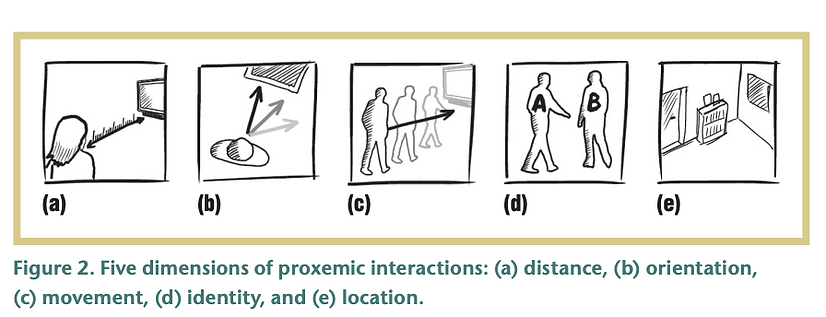
- Hall’s proxemics zones - Marquardt, N., & Greenberg, S. (2012). Informing the design of proxemic interactions. IEEE Pervasive Computing, 11(2), 14-23
Introduction
“People tend to get closer when their relation is more intimate. In other words, social and physical distances tend to match one another”
- Marco et al., 2011
Marco et al. (2011) discovered the above result from a research study, stressing that social and physical distances are profoundly correlated with each other. It is a universal phenomenon that when the relationship between two people is closer, the physical distance is also going to be closer naturally. However, this may differ depedning on various factors such as gender or age difference.
As supported by Hall (1968),
“Virtually everything that man is and does is associated with space. Not only does each of these constitute a complex system (as for example, the dozen or more different ways of experiencing depth visually), but each is molded and patterned by culture. Hence people reared in different cultures live in different sensory worlds”
Therefore, the way Toyoko kids handle proxemics, especially with strangers might be greatly different compared to normal occasions that can be seen in day-to-day lives.
Stages observed:
Observe
A gourp of Toyoko kids were standing in the Toyoko hiroba. They would keep a great distance from us to indicate the boundary. Sometimes our eyes would meet. However, for most of the time when our eyes met, we would all look away, indicating disinterest towards each other. Here, civil inattention proposed by Goffman (1991) is exemplified.
“one gives to another enough visual notice to demonstrate that one appreciates that the other is present, while at the next moment withdrawing one’s attention from him so as to express that he does not constitute a target of special curiosity or design” (Goffman, 1991, p.103).
On the other hand, one Toyoko kid kept doing eye contact with us, implying an interest in trying to know who we are. At this stage, there is a great physcial distance between us and Toyoko kid. As time passes by, the times of our eye contacts became more. It can either be inferred as that the Toyoko kid was showing interest with us and was thinking about further movement or it could be because of he sensed a “territory breach” from us so he wanted to make sure we would not violate their “territory”.


- Hall’s proxemics zones - ; Marquardt, N., & Greenberg, S. (2012). Informing the design of proxemic interactions. IEEE Pervasive Computing, 11(2), 14-23
Far distance > close distance
Depending on the eye contact result from the first stage, Toyoko kids would either stay at the original place or shrink the physical physical distance by walking toward us. We kept doing eye contact with one Toyoko kid (male, who looks like he is in his late 20s). After a while, he walked toward us, and we started to have a conversation. There is a proxemics change from a far physical distance to a close distance. Then, the Toyoko kid started making conversation with us by asking some casual questions.
Here, the proxemic changes from public distance to social distance.
Standing position
During the conversation, at first, it was me and my group member (Yuta) and the Toyoko kid standing in a triangle shape and talking. We kept a certain physical distance from each other. Later on, one more Toyoko kid (male) joined us. there was an instant proxemics change happening among us. We stand in a rectangular shape with two Toyoko kids on one side and me and my group member on the other side. This shift of proxemics reveals our social relations with each other, more specifically, “Uchi - Soto” relations. Two Toyoko kids would categorise each other as “Uchi”, meaning insides and they would see us as “Soto”, meaning outsiders, and vice versa.
Physical distance between Insiders (two Toyoko kids; me and my group member) would be personal distance while the physical distance bwteen us and the two Toyoko kids fit into the criteria of social distance.
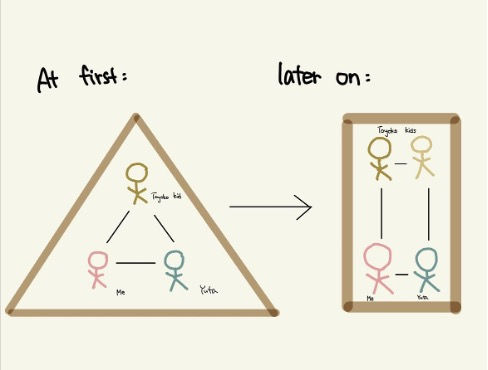
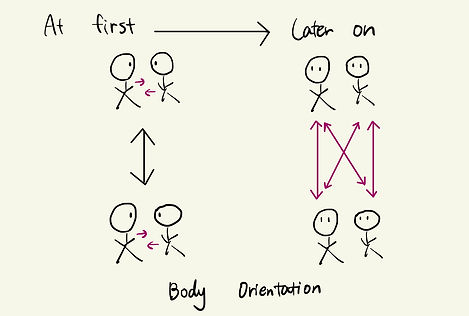
Body Orientation
At first when we were talking in the group (two Toyoko kids, me and my group member), it was like two Toyoko kids’ toes facing each other, and their bodies were slightly facing each other as well. Similarly, me and Yuta faced each other for a little bit while talking with them.
After a while, there was a slight change in all of our body orientation as we stand face to face to each other rather than facing our own members, which shows that all of us let our guards down toward strangers gradually during the process of getting to know each other.
Body touch /Movement
During the conversation, they had many body touches such as touching each other’s arms and shoulders. Neither of them revealed any offensiveness. As conversation proceeding, the two Toyoko kids started to do some body touches to my group member (Yuts) such as touching his shoulder while talking. They try to be friendly through the use of some small body touches.
As presented by Southworth (2000), male-male personal space is closer to each other compared to male-female. Therefore, it can concluded that there is a difference in proxemics between same gender and different gendes.
Furthermore, according to Madden (1999)
“Women would be spatially invsded more frequently than men”
“It was maintained that the uneqaul power distribution among men and women would manifest itself in their proxemic behaviors such as the use of distance”
Both of these quotes suggest women’s personal space is invaded by men in many of the occasions. However, in Toyoko Hiroba, observed things were different from what were mentioned by Madden. Throughout the entire time, they only did body touches to my group member (male) not me (female). There might been a consideration or respect toward me as both of them are male Toyoko kids and I am a female. Also, the proxemics use might differ depending on gender, especially with strangers.

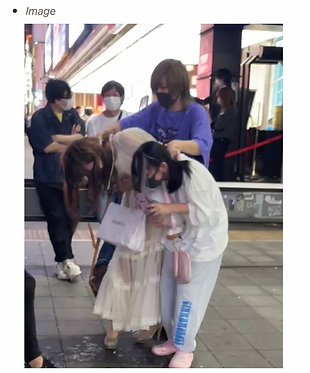
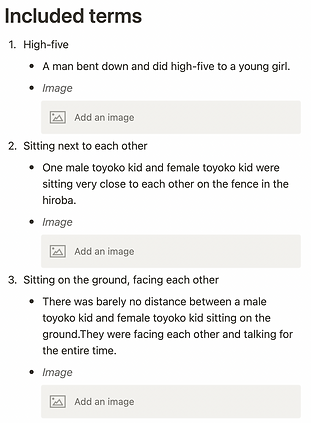
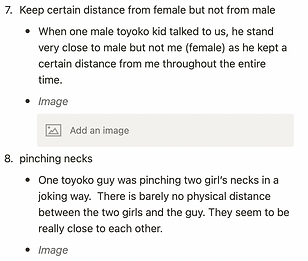


🪶Look for more detailed information here, regarding different gender proxemics →
Proxemics change
Conclusion
Proxemics observed among Toyoko kids is generally the same as the rest of the society, as they would first keep either a public or a social distance from strangers and gradually change their proxemics depending on the reactions of people. However, one thing that is specifically unique found among Toyoko kids is that it takes much lesser time for them to build relationship with strangers and the proxemics changes from public distance to personal distance in a comparative short period of time, such as after a few minutes of talking. In conclusion, Toyoko kids would invade others’ personal space (0.5 – 1m) of quite often the cases. Staying in a very intimate physical distance with strangers might be Toyoko kids’ strategy to establish interpersonal relationships with others or to show friendliness, which is not commonly seen in day-to-day life in other parts of Japan.
Click here for information on strangers interacting.
Kansasb, 2013.
After observing reactions from the previous stage, whether the person getting body touch from Toyoko kid looks annoyed or fine, they make changes on proxemics. Since my group member did not show any dislike toward body touch from the Toyoko kid, the Toyoko kid started to stand closer to us. Proxemics changes from social distance to personal distance. (refer to Hall’s proxemics zone above).
As personal space is more shared among freinds, family members or people that we are close to emotionally, many people would feel a little bit uncomfortabl when our personal space is invaded by strangers. Through our observations, when Toyoko kids talk to strangers after a while, the distance between them gets closer on most occasions, meaning that they are invading the others’ personal space quite often. This can be considered a strategy of how they build relationships with strangers by deliberately invading other peoples’ personal space to try to get close with them through physical distance first and then following by emotional distance. Toyoko kids observe peoples’ reactions toward their calculated use of proxemics to discern whether those strangers are willing to build relationship with them or not.
“Difference in Proxemics between Males and Females” - Kansas Bayly, 2013


- Three main sections -
Sections
proxemics
